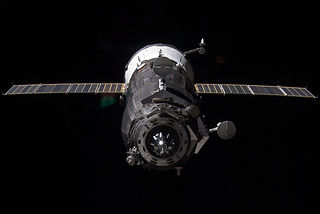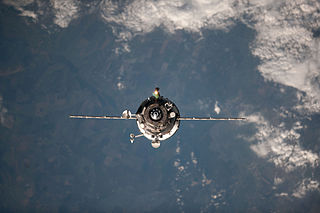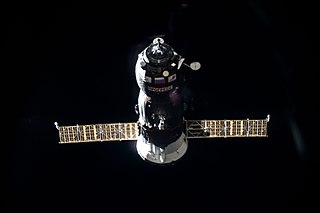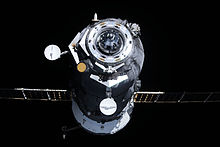
Pirs(Russian: Пирс, meaning "pier") – also called Stykovochny Otsek 1 and DC-1 – was a Russian module on the International Space Station (ISS). Pirs was launched on 14 September 2001, and was located on the Zvezda module of the station. It provided the ISS with one docking port for Soyuz and Progress spacecraft, and allowed egress and ingress for spacewalks by cosmonauts using Russian Orlan space suits. Pirs was docked to Zvezda for almost 20 years, until 26 July 2021, when it was decommissioned and undocked by Progress MS-16 to make way for the new Nauka module.

Rassvet , also known as the Mini-Research Module 1 and formerly known as the Docking Cargo Module, is a component of the International Space Station (ISS). The module's design is similar to the Mir Docking Module launched on STS-74 in 1995. Rassvet is primarily used for cargo storage and as a docking port for visiting spacecraft. It was flown to the ISS aboard Space ShuttleAtlantis on the STS-132 mission on 14 May 2010, and was connected to the ISS on 18 May 2010. The hatch connecting Rassvet with the ISS was first opened on 20 May 2010. On 28 June 2010, the Soyuz TMA-19 spacecraft performed the first docking with the module.

Expedition 27 was the 27th long-duration expedition to the International Space Station (ISS), starting on 16 March 2011. Expedition 27 saw numerous notable events, including the undocking of the Progress M-09M and Kounotori 2 spacecraft, the arrival of the Soyuz TMA-21 and Progress M-10M spacecraft, and the final rendezvous with the ISS of NASA's Space Shuttle Endeavour, on its last mission, STS-134. The expedition ended on 23 May 2011 with the departure of the Soyuz TMA-20 spacecraft, although command of the station was ceremonially handed over to the crew of Expedition 28 on 22 May.

Expedition 28 was the 28th long-duration expedition to the International Space Station, and began on 23 May 2011 with the departure of the members of Expedition 27. The first three members of Expedition 28 arrived on the ISS aboard the Soyuz TMA-21 spacecraft on 4 April 2011, and were joined on 9 June 2011 by the three other crew members, who arrived aboard Soyuz TMA-02M. The expedition saw a number of significant events, including the final Space Shuttle mission, STS-135, which took place in July 2011. Expedition 28 was superseded by Expedition 29 on 16 September 2011.

Progress M-01M, identified by NASA as Progress 31P, was a Progress spacecraft used to resupply the International Space Station. It was the first flight of the Progress-M 11F615A60, which featured a TsVM-101 digital flight computer and MBITS digital telemetry system, in place of the earlier analogue systems. It was the first Progress-M 11F615A60 spacecraft, and had the serial number 401.

Progress M-64, identified by NASA as Progress 29P, was a Progress spacecraft used to resupply the International Space Station. It was a Progress-M 11F615A55 spacecraft, with the serial number 364.
Progress M-67 was a Progress spacecraft which was used for the Progress 34P flight to resupply the International Space Station. It was a Progress-M 11F615A55 spacecraft, with the serial number 367. Its flight to the ISS marked the final flight of the Progress-M 11F615A55 model, which was retired in favour of the modernised Progress-M 11F615A60.

Progress M-03M, identified by NASA as Progress 35P, was a Progress spacecraft used by the Russian Federal Space Agency to resupply the International Space Station (ISS).

Progress M-05M, identified by NASA as Progress 37P, is a Progress spacecraft launched by the Russian Federal Space Agency in April 2010 to resupply the International Space Station (ISS). The spacecraft carried fresh food and supplies for the ISS crew. Progress M-05M also hauled some special care packages for the station crew that included confectioneries, books and new movies.

Progress M-08M, identified by NASA as Progress 40P, is a Progress spacecraft which was used to resupply the International Space Station. It was the eighth Progress-M 11F615A60 spacecraft to be launched, the fifth for the year 2010. The spacecraft was manufactured by RKK Energia, and was operated by the Russian Federal Space Agency. It arrived at the space station on 30 October 2010 whilst the Expedition 25 crew was aboard, and departed during Expedition 26 on 24 January 2011.

Progress M-09M, identified by NASA as Progress 41P, is a Progress spacecraft which was launched in 2011 to resupply the International Space Station. It was the ninth Progress-M 11F615A60 spacecraft to be launched, and has the serial number 409. The spacecraft was manufactured by RKK Energia, and is operated by the Russian Federal Space Agency. It arrived at the space station during Expedition 26, and undocked during Expedition 27.

Progress M-13M, identified by NASA as Progress 45P, is a Progress spacecraft which reached the International Space Station (ISS) on 2 November 2011. The Progress M-13M spacecraft lifted off from the Baikonur Cosmodrome in Kazakhstan at 10:11 UTC on 30 October 2011, starting off the 45th uncrewed Russian space station resupply mission. The spacecraft was manufactured by RKK Energia, and is operated by the Russian Federal Space Agency. The Soyuz-U rocket carrying the cargo ship functioned nominally as advertised. Approximately nine minutes into the launch, Progress M-13M reached its planned preliminary orbit.

Progress M-15M, identified by NASA as Progress 47P, is a Progress spacecraft used by Roskosmos to resupply the International Space Station during 2012. The fifteenth Progress-M 11F615A60 spacecraft, it has the serial number 415 and was built by RKK Energia. It arrived at the ISS in late April to deliver supplies to the Expedition 30 crew, and departed the ISS in late July 2012.

Progress M-23M, identified by NASA as Progress 55P, is a Progress spacecraft used by Roskosmos to resupply the International Space Station (ISS) during 2014. Progress M-23M was launched on a six-hours rendezvous profile towards the ISS. The 23rd Progress-M 11F615A60 spacecraft to be launched, it had the serial number 423 and was built by RKK Energia.

Progress M-24M, identified by NASA as Progress 56P, is a Progress spacecraft used by Roskosmos to resupply the International Space Station (ISS) during 2014. Progress M-24M was launched on a six-hours rendezvous profile towards the ISS. The 24th Progress-M 11F615A60 spacecraft to be launched, it had the serial number 424 and was built by RKK Energia.

Progress M-25M, identified by NASA as Progress 57P, is a Progress spacecraft used by Roskosmos to resupply the International Space Station (ISS) during 2014. Progress M-25M was launched on a six-hours rendezvous profile towards the ISS. The 25th Progress-M 11F615A60 spacecraft to be launched, it had the serial number 425 and was built by RKK Energia.

Progress MS-01, identified by NASA as Progress 62P was a Progress spaceflight operated by Roscosmos to resupply the International Space Station (ISS) in 2015. It was launched on 21 December 2015, to deliver cargo to the ISS. Progress MS-01 is the first vehicle in the Progress-MS series.

Progress MS-03, identified by NASA as Progress 64P, was a Progress spaceflight operated by Roscosmos to resupply the International Space Station (ISS). It was the first Progress MS to have an external compartment for releasing satellites.

Progress MS-15, Russian production No. 444, identified by NASA as Progress 76P, was a Progress spaceflight operated by Roscosmos to resupply the International Space Station (ISS). This was the 167th flight of a Progress spacecraft.

Progress MS-16, Russian production No. 445, identified by NASA as Progress 77P, was a Progress spaceflight operated by Roscosmos to resupply the International Space Station (ISS). This was the 168th flight of a Progress spacecraft.





















